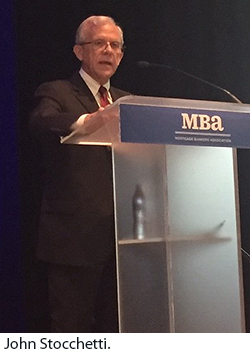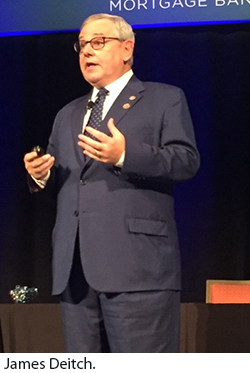
Balancing Risk in a Changing Market
CHICAGO–The real estate finance industry is experiencing large swings in volume, in part because of strong movement in mortgage interest rates, which are at more than three-year lows.
 Many lenders are moving to a more digital process to lower costs, increase efficiency and improve the customer experience.
Many lenders are moving to a more digital process to lower costs, increase efficiency and improve the customer experience.
“I am reminded of old Chinese curse, ‘May you live in interesting times,'” said John Stocchetti, Executive Vice President and Group Head of the Mortgage Partnership Finance Program with the Federal Home Loan Bank of Chicago, here at the Mortgage Bankers Association’s Risk Management, QA and Fraud Prevention Forum. “The challenge for us is to find the right balances and the right partnerships.”
Stocchetti said technology is critical to finding balance. “Applied correctly, technology can improve processes and customer experience,” he said. “Without being overly dramatic, misapplying technology can be disastrous.”
Stocchetti noted two groups that will have an impact on the future of the housing market are Millennials and minorities. “For Millennials, technology is only part of the story,” he said. “Social media plays a huge role as well.” He said while Millennials are technology-driven, they still face a steep learning curve with financial education. “Good communication is essential in dealing with them,” he said.
Stocchetti said minority outreach is also critical–particularly as minorities become, in some cases, majorities. “If we want to serve all of our communities, we need to promote understanding,” he said.
Stocchetti added that lenders and regulators should have the same goals. “If we don’t resolve our issues, it’s the customers who lose,” he said. “Risk management is more than quantitative–it’s also qualitative, and conflict should be a path to resolution, not division. Without balance and partnership, we all lose.”
 James M. Dietch, CMB, CEO of Teraverde Financial, Lancaster, Pa., said to look at how data can effectively be used for risk management and control, it helps to look outside the mortgage box–such as Southwest Airlines and the Oakland A’s.
James M. Dietch, CMB, CEO of Teraverde Financial, Lancaster, Pa., said to look at how data can effectively be used for risk management and control, it helps to look outside the mortgage box–such as Southwest Airlines and the Oakland A’s.
“Both organizations have a high percentage of labor as a high cost of business,” Deitch said. “Both are customer-facing organizations. And both use data very effectively to manage costs and balance risk.”
The A’s, of course, were the subject of Moneyball, the 2011 movie that documented how General Manager Billy Beane (a frequent speaker at MBA conferences) used data to produce the most efficient record in baseball based on cost per player. “One of the things you have to do is believe in the data and believe in data-driven decision-making,” Beane told Deitch. “There will be times when you feel like it isn’t working, but it is.””
Deitch noted that for many companies, access data is hampered by legacy systems that keep it held hostage. “The hostage-taking has to be overcome,” he said. “But you can also benchmark yourself through third-party data.”
Deitch said that lesson applies to mortgage banking as well. “One of the things you can do, as a mortgage banker, is figure out how to produce the best cost per loan,” he said. “If we don’t get a handle on analyzing costs per loan, you’re never going to make loans more efficiently. The ability to take this data and take it to the front–to reduce errors and make sure the data is right at the very beginning–can really make the difference between a company that is middle of the pack regarding efficiency and one that is top of the pack.”
